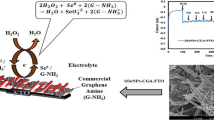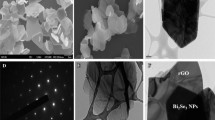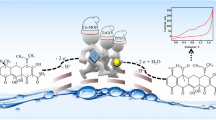Abstract
MXenes are two-dimensional materials that are attractive for applications as sensors because they possess high conductivity, super hydrophilicity and high surface area. There already exist substantial researches on the use of Ti3C2Tx based MXenes as electrochemical biosensors, but in contrast Ti2CTX based MXenes are rarely discussed due to their inherent resistance instability. However, the use of Ti2CTX based MXenes is still worth exploring as theoretical studies have shown that Ti2CTX possesses a significantly lower bandgap compared to many other MXenes structures. Herein, this study examines the use of Ti2CTX MXene structures in a P-channel ion-sensitive field-effect transistor (P-ISFET) for the detection of Chlorpyrifos (Cpy). Compositing the PEDOT:PSS thin film with delaminated Ti2CTX MXenes flakes with graphene oxide (GO) and bovine serum albumin (BSA) allows it to maintain its sheet resistance at around 100 kOhm for 3 days. Interestingly when using the composite thin film, the minimum threshold voltage required to observe Cpy electroreduction is −0.1 V. This is much lower than that when using titanium dioxide (TiO2), which is −1.5 V. Composite thin films containing Ti2CTX MXene are found to detect Cpy with higher sensitivity compared to thin films without MXene. This is because the presence of Mxene in the PEDOT:PSS composite thin films improves the surface area available for Cpy detection. This study highlights the potential of Ti2CTx MXene-BSA composite as a promising 2D material for enzyme-free CPY detection.









Similar content being viewed by others
References
Seung KH, Kim DH, Kim TW (2021) Organic light-emitting devices based on conducting polymer treated with benzoic acid. Sci Rep 11(1):1–9
Galliano S, Bella F, Bonomo M, Giordano F, Grätzel M, Viscardi G, Hagfeldt A, Gerbaldi C, Barolo C (2021) Xanthan‐based hydrogel for stable and efficient quasi‐solid truly aqueous dye‐sensitized solar cell with cobalt mediator. Solar Rrl, p 2000823
Galliano S, Bella F, Bonomo M, Viscardi G, Gerbaldi C, Boschloo G, Barolo C (2020) Hydrogel electrolytes based on xanthan gum: green route towards stable dye-sensitized solar cells. Nanomaterials 10(8):1585
Fagiolari L, Varaia E, Mariotti N, Bonomo M, Barolo C, Bella F (2021) Poly (3, 4‐ethylenedioxythiophene) in dye‐sensitized solar cells: toward solid‐state and platinum‐free photovoltaics. Adv Sustain Syst, p 2100025
Amici J, Torchio C, Versaci D, Dessantis D, Marchisio A, Caldera F, Bella F, Francia C, Bodoardo S (2021) Nanosponge-based composite gel polymer electrolyte for safer Li-O2 batteries. Polymers 13(10):1625
Piana G, Ricciardi M, Bella F, Cucciniello R, Proto A, Gerbaldi C (2020) Poly (glycidyl ether) recycling from industrial waste and feasibility study of reuse as electrolytes in sodium-based batteries. Chem Eng J 382:122934
Bella F, Porcarelli L, Mantione D, Gerbaldi C, Barolo C, Grätzel M, Mecerreyes Da (2021) A water-based and metal-free dye solar cell exceeding 7% efficiency using a cationic poly (3, 4-ethylenedioxythiophene) derivative. Chem Sci 11(6):1485–1493
Xu S, Shi XL, Dargusch M, Di C, Zou J, Chen ZG (2020) Conducting polymer-based flexible thermoelectric materials and devices: from mechanisms to applications. Prog Mater Sci 121:100840
Chen J, Zhu Y, Huang J, Zhang J, Pan D, Zhou J, Guo Z (2021) Advances in responsively conductive polymer composites and sensing applications. Polym Rev 61(1):157–193
Xu S, Shi XL, Dargusch M, Di C, Zou J, Chen ZG (2021) Conducting polymer-based flexible thermoelectric materials and devices: from mechanisms to applications. Prog Mater Sci 121:100840
Cui J, Xing F, Luo H, Qin J, Li Y, Zhong Y, Wei F et al (2021) General synthesis of hollow mesoporous conducting polymers by dual-colloid interface co-assembly for high-energy-density micro-supercapacitors. J Energy Chem 62:145–152
Zheng X, Shen J, Hu Q, Nie W, Wang Z, Zou L, Li C (2021) Vapor phase polymerized conducting polymer/MXene textiles for wearable electronics. Nanoscale 13(3):1832–1841
Luo X, Yang G, Schubert DW (2021) Electrically conductive polymer composite containing hybrid graphene nanoplatelets and carbon nanotubes: synergistic effect and tunable conductivity anisotropy. Adv Comp Hybrid Mater, pp 1–13
Song P, Liu B, Qiu H, Shi X, Cao D, Gu J (2021) MXenes for polymer matrix electromagnetic interference shielding composites: a review. Comp Commun, p 100653
Wang M, Tang XH, Cai JH, Wu H, Shen JB, Guo SY (2021) Construction, mechanism and prospective of conductive polymer composites with multiple interfaces for electromagnetic interference shielding: a review. Carbon
Zhu X, Hu Y, Wu G, Chen W, Bao N (2021) Two-dimensional nanosheets-based soft electro-chemo-mechanical actuators: recent advances in design, construction, and applications. ACS nano
Won P, Jeong S, Majidi C, Ko SH (2021) Recent advances in liquid metal based wearable electronics and materials. iScience, p 102698
Zhao B, Hamidinejad M, Wang S, Bai P, Che R, Zhang R, Park CB (2021) Advances in electromagnetic shielding properties of composite foams. J Mater Chem A 9(14):8896–8949
Qin S, Usman KAS, Hegh D, Seyedin S, Gogotsi Y, Zhang J, Razal JM (2021) Development and applications of MXene-based functional fibers. ACS Appl Mater Interfaces 13(31):36655–36669
Usman KAA, Qin S, Henderson LC, Zhang J, Hegh D, Razal JM (2021) Ti3C2Tx MXene: from dispersions to multifunctional architectures for diverse applications. Mater Horizons
Moses OA, Gao L, Zhao H, Wang Z, Adam ML, Sun Z, Yu X (2021) 2D materials inks toward smart flexible electronics. Materi Today
Zhan X, Si C, Zhou J, Sun Z (2020) MXene and MXene-based composites: synthesis, properties and environment-related applications. Nanoscale Horizons 5:235–258
Naguib M, Mochalin VN, Barsoum MW, Gogotsi Y (2014) 25th anniversary article: MXenes: a new family of two-dimensional materials. Adv Mater 26:992–1005
Xie Y, Dall’Agnese Y, Naguib M, Gogotsi Y, Barsoum MW, Zhuang HL, Kent PRC (2014) Prediction and characterization of MXene nanosheet anodes for non-lithium-ion batteries. ACS Nano 8:9606–9615
Xie Y, Naguib M, Mochalin VN, Barsoum MW, Gogotsi Y, Yu X, Nam K-W, Yang X-Q, Kolesnikov AI, Kent PRC (2014) Role of surface structure on Li-ion energy storage capacity of two-dimensional transition-metal carbides. J Am Chem Soc 136:6385–6394
Jastrzębska AM, Karwowska E, Wojciechowski T, Ziemkowska W, Rozmysłowska A, Chlubny L, Olszyna A (2019) The atomic structure of Ti 2 C and Ti 3 C 2 MXenes is responsible for their antibacterial activity toward E. coli bacteria. J Mater Eng Perform 28:1272–1277
Lai S, Jeon J, Jang SK, Xu J, Choi YJ, Park J-H, Hwang E, Lee S (2015) Surface group modification and carrier transport properties of layered transition metal carbides (Ti2CTx, T:–OH,–F and–O). Nanoscale 7:19390–19396
Mohan SV, Sirisha K, Rao NC, Sarma PN, Reddy SJ (2004) Degradation of chlorpyrifos contaminated soil by bioslurry reactor operated in sequencing batch mode: bioprocess monitoring. J Hazard Mater 116:39–48
Gouveia JD, Novell-Leruth G, Reis PMLS, Viñes F, Illas F, Gomes JRB (2020) First-principles calculations on the adsorption behavior of amino acids on a titanium carbide MXene. ACS Appl Bio Mater 3:5913–5921
Prats H, McAloone H, Viñes F, Illas F (2020) Ultra-highly selective biogas upgrading through porous MXenes. J Mater Chem A 8:12296–12300
Zhao S, Kang W, Xue J (2014) Role of strain and concentration on the Li adsorption and diffusion properties on Ti2C layer. J Phys Chem C 118:14983–14990
He Y, Zhou X, Zhou L, Zhang X, Ma L, Jiang Y, Gao J (2020) Self-reduction prussian blue on Ti3C2Tx MXenes nanosheets as dual-functional nanohybrid for hydrogen peroxide and pesticide sensing. Ind Eng Chem Res
Kalambate PK, Gadhari NS, Li X, Rao Z, Navale ST, Shen Y, Patil VR, Huang Y (2019) Recent advances in MXene–based electrochemical sensors and biosensors. TrAC Trends Anal Chem 120:115643
Zhao F, Yao Y, Jiang C, Shao Y, Barceló D, Ying Y, Ping J (2020) Self-reduction bimetallic nanoparticles on ultrathin MXene nanosheets as functional platform for pesticide sensing. J Hazard Mater 384:121358
Gao G, O’Mullane AP, Du A (2017) 2D MXenes: a new family of promising catalysts for the hydrogen evolution reaction. ACS Catal 7:494–500
Solomon KR, Williams WM, Mackay D, Purdy J, Giddings JM, Giesy JP (2014) Properties and uses of chlorpyrifos in the United States. Ecol Risk Assess Chlorpyrifos Terr Aquat Syst 8:13–34
Wang D, Singhasemanon N, Goh KS (2016) A statistical assessment of pesticide pollution in surface waters using environmental monitoring data: Chlorpyrifos in Central Valley, California. Sci Total Environ 571:332–341
Mohan HKSV, Chee WK, Li Y, Nayak S, Poh CL, Thean AVY (2020) A highly sensitive graphene oxide based label-free capacitive aptasensor for vanillin detection. Mater Des 186:108208
Wang L, Song H, Yuan L, Li Z, Zhang Y, Gibson JK, Zheng L, Chai Z, Shi W (2018) Efficient U (VI) reduction and sequestration by Ti2CT x MXene. Environ Sci Technol 52:10748–10756
Kugimiya A, Babe F (2011) Phosphate ion sensing using molecularly imprinted artificial polymer receptor. Polym Bull 67(9):2017–2024
Berchmans S, Balamurugan T (2021) Immobilization of molecular assemblies on 2D nanomaterials for electrochemical biosensing applications. In: Immobilization strategies. Springer, Cham, pp 435–474
Liu F, Nie P, He X, Liu X (2021) Soil information sensing technology. In: Agricultural internet of things. Springer, Cham, pp 99–120
Mohd Razib MS, Latip W, Abdul Rashid JI, Knight VF, Wan Yunus WMZ, Ong KK, Mohd Noor SA (2021) An enzyme-based biosensor for the detection of organophosphate compounds using mutant phosphotriesterase immobilized onto reduced graphene oxide. J Chem
Li Y, Peng Z, Holl NJ, Hassan MR, Pappas JM, Wei C, Wu C (2021) MXene–graphene field-effect transistor sensing of influenza virus and SARS-CoV-2. ACS Omega 6(10):6643–6653
Ranjan P, Thomas V, Kumar P (2021) 2D materials as a diagnostic platform for the detection and sensing of the SARS-CoV-2 virus: a bird’s-eye view. J Mater Chem B 9:4608–4619
Eklund P, Rosen J, Persson POÅ (2017) Layered ternary M n+ 1AX n phases and their 2D derivative MXene: an overview from a thin-film perspective. J Phys D Appl Phys 50:113001
Zhou T, Wu C, Wang Y, Tomsia AP, Li M, Saiz E, Fang S, Baughman RH, Jiang L, Cheng Q (2020) Super-tough MXene-functionalized graphene sheets. Nat Commun 11:1–11
Hsieh S-R, Reddy PM, Chang C-J, Kumar A, Wu W-C, Lin H-Y (2016) Exploring the behavior of bovine serum albumin in response to changes in the chemical composition of responsive polymers: Experimental and simulation studies. Polymers (Basel) 8:238
Carter DC, Ho JX (1994) Structure of serum albumin. In: Adv Protein Chem. Elsevier, London, pp 153–203
Hirayama K, Akashi S, Furuya M, Fukuhara K (1990) Rapid confirmation and revision of the primary structure of bovine serum albumin by ESIMS and Frit-FAB LC/MS. Biochem Biophys Res Commun 173:639–646
Kubal G, Sadler PJ, Evans RW (1992) Sequential binding of aluminum (3+) to the C-and N-lobes of human serum transferrin detected by proton NMR spectroscopy. J Am Chem Soc 114:1117–1118
Hampitak P, Melendrez D, Iliut M, Fresquet M, Parsons N, Spencer B, Jowitt T, Vijayaraghavan A (2020) Protein interactions and conformations on graphene-based materials mapped using quartz-crystal microbalance with dissipation monitoring (QCM-D). Carbon NY 165:317–327
Zhang H, Zhu Z, Wang Y, Fei Z, Cao J (2018) Changing the activities and structures of bovine serum albumin bound to graphene oxide. Appl Surf Sci 427:1019–1029
Jachimska B, Tokarczyk K, Łapczyńska M, Puciul-Malinowska A, Zapotoczny S (2016) Structure of bovine serum albumin adsorbed on silica investigated by quartz crystal microbalance. Colloids Surf A Physicochem Eng Asp 489:163–172
Phan HTM, Bartelt-Hunt S, Rodenhausen KB, Schubert M, Bartz JC (2015) Investigation of bovine serum albumin (BSA) attachment onto self-assembled monolayers (SAMs) using combinatorial quartz crystal microbalance with dissipation (QCM-D) and spectroscopic ellipsometry (SE). PLoS ONE 10:e0141282
Kubiak-Ossowska K, Tokarczyk K, Jachimska B, Mulheran PA (2017) Bovine serum albumin adsorption at a silica surface explored by simulation and experiment. J Phys Chem B 121:3975–3986
Bhowal AC, Talukdar H, Kundu S (2019) Preparation, characterization and electrical behaviors of PEDOT: PSS-Au/Ag nanocomposite thin films: an ecofriendly approach. Polym Bull 76(10):5233–5251
Yu T, Breslin CB (2019) Two-dimensional titanium carbide MXenes and their emerging applications as electrochemical sensors. J Electrochem Soc 167:37514
Come J, Naguib M, Rozier P, Barsoum MW, Gogotsi Y, Taberna P-L, Morcrette M, Simon P (2012) A non-aqueous asymmetric cell with a Ti2C-based two-dimensional negative electrode. J Electrochem Soc 159:A1368
Echols IJ, An H, Zhao X, Prehn EM, Tan Z, Radovic M, Green MJ, Lutkenhaus JL (2020) pH-Response of polycation/Ti3C2Tx MXene layer-by-layer assemblies for use as resistive sensors. Mol Syst Des Eng 5:366–375
Wang S, Liu Y, Lü Q-F, Zhuang H (2020) Facile preparation of biosurfactant-functionalized Ti2CTX MXene nanosheets with an enhanced adsorption performance for Pb (II) ions. J Mol Liq 297:111810
Han C-G, Qian X, Li Q, Deng B, Zhu Y, Han Z, Zhang W, Wang W, Feng S-P, Chen G (2020) Giant thermopower of ionic gelatin near room temperature. Science 368:1091–1098
Kumaravel A, Chandrasekaran M (2015) Electrochemical determination of chlorpyrifos on a nano-TiO2/cellulose acetate composite modified glassy carbon electrode. J Agric Food Chem 63:6150–6156
Gund GS, Park JH, Harpalsinh R, Kota M, Shin JH, Kim T-I, Gogotsi Y, Park HS (2019) MXene/polymer hybrid materials for flexible AC-filtering electrochemical capacitors. Joule 3:164–176
Chen X, Zhao Y, Li L, Wang Y, Wang J, Xiong J, Yu J (2021) MXene/polymer nanocomposites: preparation, properties, and applications. Polym Rev 61(1):80–115
Aakyiir M, Oh JA, Araby S, Zheng Q, Naeem M, Ma J, Mai YW (2021) Combining hydrophilic MXene nanosheets and hydrophobic carbon nanotubes for mechanically resilient and electrically conductive elastomer nanocomposites. Comp Sci Technol 214:108997
Andrianova MS, Gubanova OV, Komarova NV, Kuznetsov EV, Kuznetsov AE (2016) Development of a biosensor based on phosphotriesterase and n-channel ISFET for detection of pesticides. Electroanalysis 28(6):1311–1321
El-Shahawi MS, Kamal MM (1998) Determination of the pesticide Chlorpyrifos by cathodic adsorptive stripping voltammetry, Fresenius. J Anal Chem 362:344–347
Al-Meqbali ASR, El-Shahawi MS, Kamal MM (1998) Differential pulse polarographic analysis of chlorpyrifos insecticide. Electroanal Int J Devoted Fundam Pract Asp Electroanal 10:784–786
Pelit FO, Ertaş H, Ertaş FN (2011) Development of an adsorptive catalytic stripping voltammetric method for the determination of an endocrine disruptor pesticide chlorpyrifos and its application to the wine samples. J Appl Electrochem 41:1279
Dahiya V, Chaubey B, Dhaharwal AK, Pal S (2017) Solvent-dependent binding interactions of the organophosphate pesticide, chlorpyrifos (CPF), and its metabolite, 3, 5, 6-trichloro-2-pyridinol (TCPy), with Bovine Serum Albumin (BSA): A comparative fluorescence quenching analysis. Pestic Biochem Physiol 139:92–100
Zhou G, Wang D-W, Yin L-C, Li N, Li F, Cheng H-M (2012) Oxygen bridges between NiO nanosheets and graphene for improvement of lithium storage. ACS Nano 6:3214–3223
Ouyang J, Xu Q, Chu C-W, Yang Y, Li G, Shinar J (2004) On the mechanism of conductivity enhancement in poly (3, 4-ethylenedioxythiophene): poly (styrene sulfonate) film through solvent treatment. Polymer (Guildf) 45:8443–8450
Kim H, Alshareef HN (2019) MXetronics: MXene-Enabled Electronic and Photonic Devices. ACS Mater Lett 2:55–70
Zhang J, Zhou P, Liu J, Yu J (2014) New understanding of the difference of photocatalytic activity among anatase, rutile and brookite TiO2. Phys Chem Chem Phys 16:20382–20386
Acknowledgements
This work was supported by UTHM-UTM CRG grant K035 and Collaborative Research in Engineering, Science and Technology (CREST), R&D Grant No. A154 & P28C1-17, and Postgraduate Research Grant No GPPS-H002. This project is also funded by Ministry of Education (Malaysia) under Fundamental Research Grant Scheme (FRGS), with a reference number of FRGS/1/2018/STG05/UTHM/02/3 or FRGS Vot No. K106. The authors also acknowledge the support from Faezahana Mohkter and Ahmad Nasrul Mohamed for their technical assistance.
Author information
Authors and Affiliations
Corresponding authors
Ethics declarations
Conflict of interest
The authors declare that there is no known conflict of interest regarding this work.
Additional information
Publisher's Note
Springer Nature remains neutral with regard to jurisdictional claims in published maps and institutional affiliations.
Rights and permissions
About this article
Cite this article
Hasnan, M.M.I.M., Lim, G.P., Nayan, N. et al. The investigation of chlorpyrifos (Cpy) detection of PEDOT:PSS-MXene(Ti2CTX)-BSA-GO composite using P-ISFET reduction method. Polym. Bull. 80, 1243–1264 (2023). https://doi.org/10.1007/s00289-022-04105-5
Received:
Revised:
Accepted:
Published:
Issue Date:
DOI: https://doi.org/10.1007/s00289-022-04105-5




